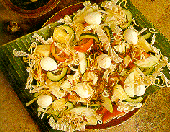| Main Menu
|
- Chinese Food
- Peranakan Food
- Malay Food
- Indian Food
- Others inclusive of Italian, Japanese and Thailand Food
- Queer Food
- Places where you can find good food
- Survey
- Introduction of the six chefs
- Acknowledgements

|
Peranakans migrated South with the early settlers who came in droves from the older settlements of Malacca and Penang on hearing news of Sir Stamford Raffles' new trading port in the early 19th century. The women are called "Nyonyas" and the men are called "Babas", so a common name we use to refer to them is "Peranakans". More often than not, we only say "Nyonya food" or "Peranakan food", but we do not say "Baba food". This is due to the fact the women do most of the cooking.
The cuisine of the Peranakan community, which evolved through the intermarriage of Chinese and Malay elements, is unique to this area. Coconut, candlenut, turmeric and fragrant lemon grass are essential to this cuisine. At the same time, it is different from Malay food in that pork is commonly used. Malays, being traditional Muslims, are not allowed to eat pork.
The Nyonyas consider cooking an accomplishment, an art to be proud of. Nyonya cuisine shows strong Malay, Indonesian and Indian influence, as seen by the curries and condiments usually found on a Baba family table. Also, Nyonya food, like other features of the Nyonya lifestyle, is a synthesis of many tastes. It is often a blend of spicy, tangy, herbal and sweet dishes.
In the backyard of Nyonya homes in olden Singapore, an assortment of herbs was almost always grown. Nowadays, most people live in high-rise flats and there is hardly any space for this. Besides, such herbs can be easily bought in Singapore. The distinctively shaped leaf of a variety of citrus called leper lime (limau purut) is added to many dishes whole or shredded. Fresh basil and coriander shoots are used lavishly as well. The delicate, frilly leaves of coriander, used for garnishing, have a pronounced and distinctive flavour. The screwpine (pandanus) is a standard flavouring for both savoury and sweet dishes. Leaves are often pounded to extract juices or used whole to wrap up meat or rice. One example is the banana leaf. After the filling is wrapped into neat little packets, they are deep-fried or steamed to extract the scent of the banana leaves.
 On the dining table, one item that is always seen is the salad. There are two main types of Nyonya salads, dry and moist. A spicy yet sweet dressing with a heavy taste of lime is always available with the salad and it is this that makes is unique.
On the dining table, one item that is always seen is the salad. There are two main types of Nyonya salads, dry and moist. A spicy yet sweet dressing with a heavy taste of lime is always available with the salad and it is this that makes is unique.
The dry salad dressing, made with roasted, grated coconut, is an indication of Sumatra influence, while the moist salad dressing is of coconut cream. A savoury salad served with peanut sauce, blanched vegetables (gado-gado) and seafood fritters is commonly known as pasembur, whereas one served with spicy, pungent, shrimp-based sauce, usually with raw vegetables, is known as ulam.

|




